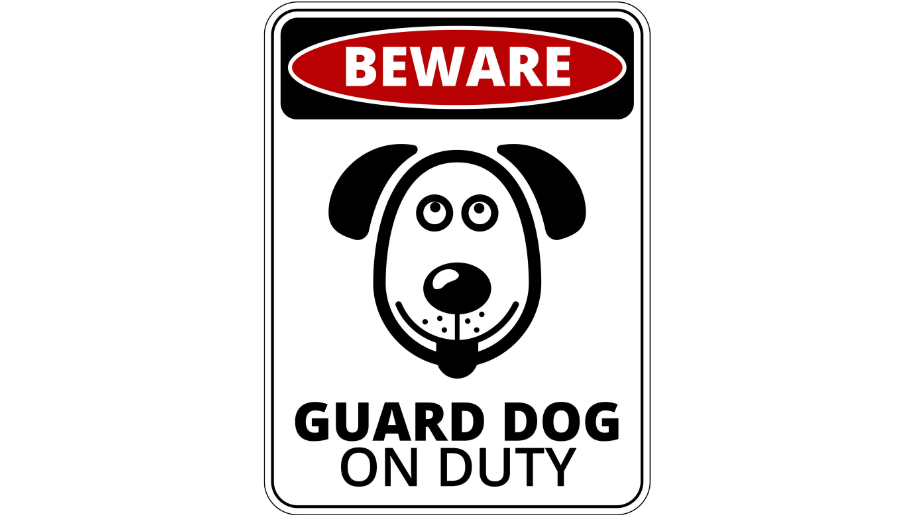
Security is one of the great essentials of life. While most of us will never have to deal with the kinds of extreme violence that we see on the news every day, the fact remains that those things happen every day. With so many restrictions on the ownership of weapons, the guard dog has become more important than ever. As someone who has trained guard dogs for a long time, I have a pretty good idea about what it takes to create a proper guard dog.
So, do Labradors make good guard dogs? In my experience, the answer is both a yes and a no. The truth is that a Labrador is generally not recommended for guard dog usage. However, they are still capable of this task when properly trained. Labradors have shown themselves to be excellent guard dogs. They possess a strong protective instinct that can easily be adapted for security work.
Having trained so many guard animals over the years, I can tell you a few of my preferred methods. Hopefully, you can use my advice to create a fierce protector that will keep you and your family safe. As you read on, be aware that this will not be an easy task.
Getting Started With Your Guard Dog Training:
If you have little or no experience in the training of dogs, the first thing you need to know is that dogs are creatures of habit. The more you repeat a lesson, the more likely they are to retain it. This rule also holds for humans, though not to the same extent. Humans can often learn things very quickly while dogs more often require long-term repetition. For this reason, it is essential to work with your dog as often as possible. I recommend that you set up a weekly schedule that can be used to plan out all your dog-training activities for the week. Doing things in an organized pattern will save time and effort.
Obedience is key to any kind of dog training, so make sure that you begin working with your dog as early as possible to establish who is the boss. You can start with simple commands like sit, stay, lay down, and shake. Don’t think that your dog will do these things without some kind of reward, because they probably won’t. The use of reward is extremely important to dog training, as it provides the motivation for proper obedience. Once your animals are established in their habits, you should refrain from rewarding them every time.
You need to determine if your animal has a strong protective instinct. As stated earlier, a Labrador is not naturally prone to attack an intruder, but they do possess a strong protective instinct and the same territorial nature that all dogs have. These qualities can be molded into a security guard, but they must be present in order for that to occur. There are several ways that you can test this quality. For instance, you might get someone in your neighborhood to pretend as if they are attacking you and/or breaking into your home. The purpose of this will be to see how the dog reacts and to reward or scold the dog appropriately. Make sure you do not use harsh physical discipline, as it is counterproductive. You want your dog to have confidence. Simply scold the dog if they do not perform as expected and try again later. When doing this, your mock attacker should wear thick clothes just in case the dog decides to bite. If the animal does bite, the attacker should run away. The purpose of this is, again, to build confidence. You want your dog to think of themselves not as a lapdog, but as a fierce protector.
Once your dog has begun to show a protective instinct, here’s another exercise you can do. Go to a pool or perhaps a creek and pretend that you are drowning. Labradors have saved people from drowning time and timeagain, as a quick google search will show. They have also been known to save other animals from drowning. It is important to encourage the protective instinct because this is the root of a guard dog’s mentality. This protective instinct will motivate them to fight in defense of their pack. You should go no further with the process until your animal is full-grown. An immature animal will not have the territorial instinct that is essential to a guard dog’s job.
The Next Steps: Trigger Words And Bite Training:
Having established the protective instinct, you must decide on a trigger word. This is a word that will be used to tell your dog when they are supposed to bite. When a dangerous situation arises, you need a one-word command that will instantly tell your dog that it is time to go into an aggressive mode. I find that it is best to use a foreign word so that the dog will not be triggered by something they hear in casual conversation. It doesn’t really matter which language you choose but make sure it is a language that is not commonly spoken in your country, and which doesn’t sound too similar to any words in your everyday language.
Begin by taking a thick rope and tying a big knot at one end. Here is my preferred method. Dangle this in front of the dog while firmly stating the trigger word. Brush it against their nose so that they will be more inclined to grab it with their teeth. Put some kind of a treat in the center of the knot. If your dog is really stubborn at this point, try boiling the rope in beef broth for a while. It is important to train your dog to bite the rope on command. Even if they only give it a small nip, they have the right idea and should be rewarded with praise and/or a treat. Once your dog has learned this trick, stand back a little and try to make him run and bite. In a self-defense situation, your dog will most likely have to run to the attacker and bite while still on the run. Therefore, this kind of bite training is more realistic.
Once your dog has mastered the rope ball, you can move on to a bite sleeve. These can either be bought or improvised, but the concept is simple. The bite sleeve is a sleeve of thick padded material that a dog cannot bite through. It must be securely fastened to the arm so that it does not come off when the dog grabs and shakes. Use it in the same way that you used the rope ball, but encourage the dog to grab and hold.
Perimeter Awareness Training:
If you want the dog to guard a certain area, they must clearly understand the boundaries of that area. Not only does this help the dog to do their job better, but it also minimizes the risk of accidents. When you walk your dog, don’t just wander aimlessly through the yard until they do their business. Instead, walk the perimeter of the yard, allowing them to mark their territory at the appropriate place. When dogs mark their territory with urine, they do it for the purpose of declaring borders. Allow them to mark the border as their instincts demand. If your dog stays indoors, they should come to understand the door and the windows as boundaries in a similar way.
Related Questions:
Is it true that a dog has to be at least two years old before beginning guard dog training?
There are many protection dog trainers that will not accept a dog for instruction unless they are at least two years of age. While this is not a bad rule for a professional to follow, it is not 100% true. It is true that a guard dog needs to be fully mature, as a puppy will seldom show a strong territorial instinct.
Does it matter if my guard dog is a male or female?
No. All dogs tend to protect the pack. While it is true that males will more often make a display of their territorial behavior, females will defend the pack just as readily as a male. In fact, a female with pups is probably the most defensive kind of dog you will ever see.
Is territorial behavior the same as aggression?
No. Territorial behavior is an inherently defensive response, while aggression is exactly the opposite. It is not desirable to have an aggressive dog under any circumstances, and there are multiple reasons for this. The first reason is that true aggression is usually created through abuse, and that is morally repugnant to all decent people. The second reason is that an aggressive dog is inherently hard to control.
What are some advanced self-defense techniques that I can teach my dog?
Some trainers will train a guard dog to take objects from the hand of an attacker so that they can better defend against an armed assailant. While a dog is likely to be hurt when they bite a knife or a live firearm, such a strategy will give them and their owner the best possible chance for survival. Many self-defense techniques that are designed for use against pistols and knives rely upon the tactic of gaining control of the weapon and keeping control of the weapon. Since it is a simple concept, a dog can be taught to do it.



